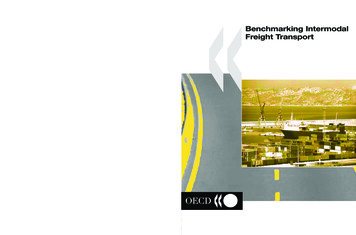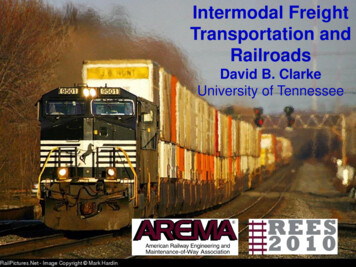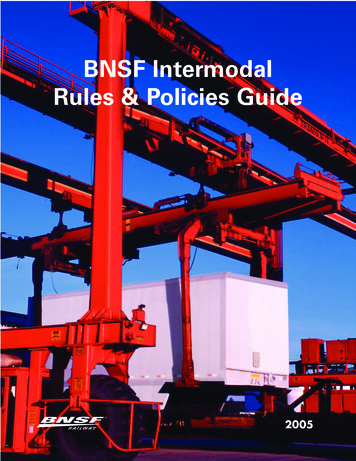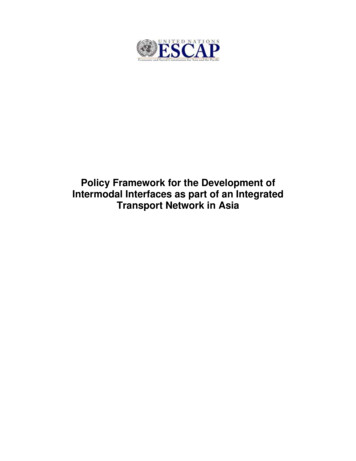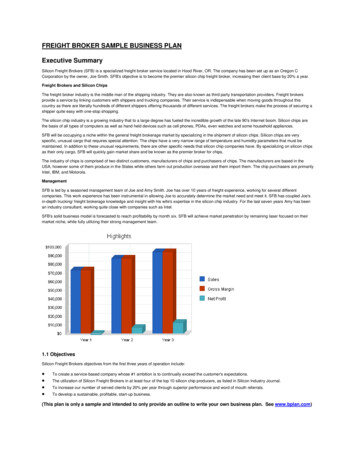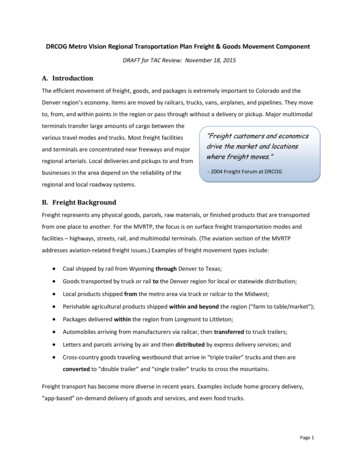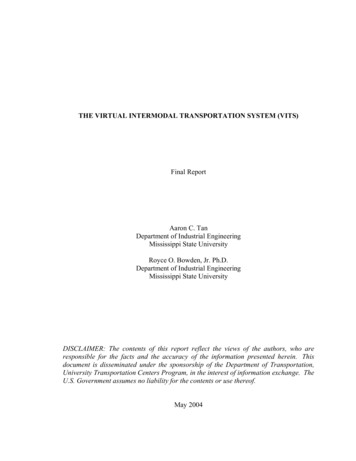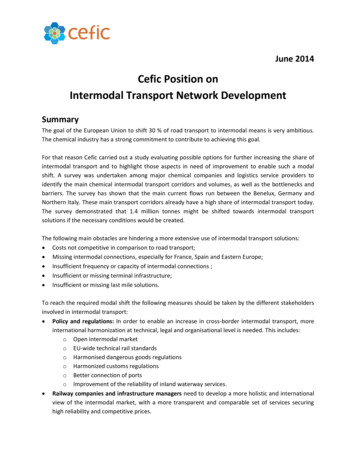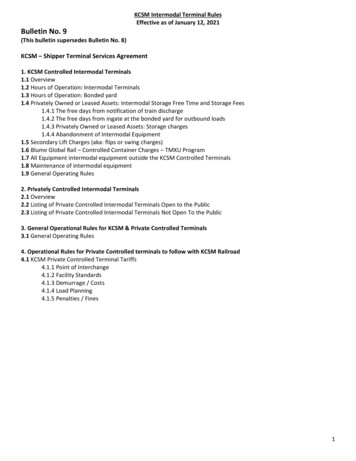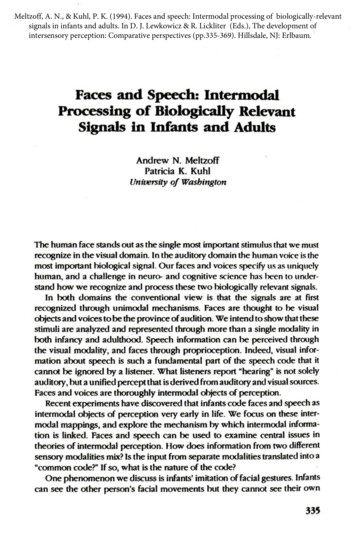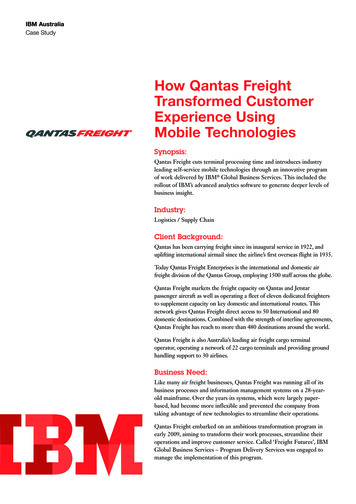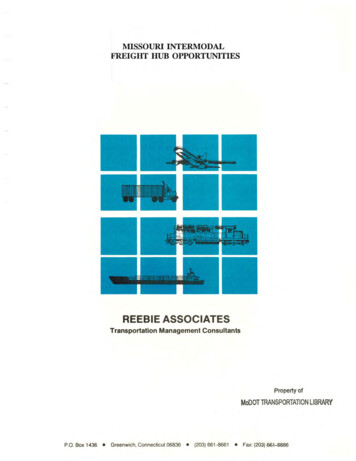
Transcription
MISSOURI INTERMODALFREIGHT HUB OPPORTUNITIESREEBIE ASSOCIATESTransportation Management ConsultantsProperty ofMoDOT TRANSPORTATION LIBRARYP.o. Box 1436 Greenwich, Connecticut 06836 (203) 661-8661 Fax: (203) 66 ·8886
MISSOURI INTERMODALFREIGHT HUB OPPORTUNITIESPrepared for:Missouri Highway andTransportation DepartmentbyReebie AssociatesStifel, Nicolaus & Company, Inc.Airport Consulting Group, Inc.November, 1993
TABLE OF CONTENTSPAGECURRENT SITUATION: INTERMODAL & MISSOURI1Brief Historical PerspectiveCurrent Status of Intennodal35MAJOR U.S. INTERMODAL MARKETS7AIR CARGO ISSUES11Locating Air Cargo HubsPotential for ExpansionCurrent Status of Air CargoIntegrated vs. Non-integrated Air CarriersInternational Air CargoPotential for Specialized RolesOpportunities for "Link Up" with CarriersSteps To Be TakenConclusion re: Air Freight Opportunities111213161617181920RAIL INTERMODAL HUBS22DEFINING THE INTERMODAL HUB25HUBS VS. SUPER-HUBS26REEBIE ASSOCIATES
TABLE OF CONTENTS (cont'd)PAGEIDENTIFICATION OF POTENTIAL MARKET AREAS IN MISSOURI 272828Land AvailabilityLabor Force AvailabilityInterstate Highway AccessRail Main Line Access & RoutesAirport & Cargo Handling FacilitiesLocal Economic BaseProximity to Major Hinterland Points2929323234IDENTIFICATION OF HINTERLAND MARKETS36DOUBLE STACK CONTAINER TRAIN POTENTIAL45Train Volume Requirements for Stack-TrainsMissouri Hub Areas' Potential Intermodal VolumeImpact of Adding "Hinterland" VolumeFuture Projections of VolumeCOMPETITIVE ECONOMICSEconomics in Specific Traffic LanesHighway Drayage Beyond the Intermodal HubPHYSICAL REQUIREMENTSEstimated Throughput VolumePhysical Requirements of the Intermodal HubScoping the "Super-HubREEBIE ASSOCIATES4547475151555657606263
TABLE OF CONTENTS (cont'd)PAGE65FINANCING OPTIONSTax-Exempt FinancingRevenue Bonds -Purchase FinancingIndustrial Development BondsTaxable FinancingTax CreditsGrantsConclusionOTHER CONSIDERAnONSHighway CompetitionLabor ForceTechnologyRail CarriersInterline FreightRail Carrier Management's ecommendationsNext StepsnREEBIE ASSOCIATES
TABLE OF FIGURFS Number1962 - 199221INTERMODAL LOADINGS2U.S. vs. INTERMODAL CORRIDOR63aTOP U.S. INTERMODAL HUBS, 1990 (page 1)83bTOP U.S. INTERMODAL HUBS, 1990 (page 2)94INTERMODAL VOLUME TRENDS 1986-1991105CURRENT AIR CARGO HUBS146MAJOR RAIUINTERMODAL TERMINALS237CURRENT HUB CENTERS AND DOUBLE-STACKCONTAINER LANES248INTERSTATE HIGHWAY ACCESS AND ROUTES309RAIL ACCESS AND ROUTES3110COMPARATIVE ECONOMIC SIZE3311FEASIBLE HINTERLAND AREAFOR OVERNIGHT OR NEXT DAY DELIVERY BY TRUCK3512MARKEr SPHERE (HINTERLAND) SIZE3713HINTERLAND AREA OF INTERMODAL HUBS - CHICAGO3914HINTERLAND AREA OF INTERMODAL HUBS - MEMPHIS4015HINTERLAND AREA OF INTERMODAL HUBS - KANSAS CITY 4116HINTERLAND AREA OF INTERMODAL HUBS - ST. LOUIS17HINTERLAND AREA OF INTERMODAL HUBS - NEW ORLEANS 4318STACK TRAIN VOLUME REQUIREMENTSREEBIE ASSOCIATES4248
TABLE OF FIGUREs (cont'd) Number19CONTAINERIZABLE TRAFFIC POTENTIAL - 19904920CONTAINERIZABLE TRAFFIC POTENTIAL - 20005221COST COMPARISON FOR RAIL AND TRUCK5422INTERMODAL COST ADV ANTAGES vs. ALL-HIGHWAY5823DIRECTIONAL EFFECr ON FEASIBLE HINTERLAND59REEBIE ASSOCIATES
MISSOURI lllGHWAY & TRANSPORTATION DEPARTMENTINTERMODAL FREIGHT HUB OPPORTUNITIESCURRENT SITUATION: INTERMODAL & MISSOURIIntermodal transportation, described as the new hope for improved efficiency, reliabilityand cost savings since the 1950s, is still making headlines in the 1990s as the bright prospectfor the future in transportation of containerizable freight. And, indeed, real cost savings andservice improvements have been seen in the past several years -- especially with the large scalemovement towards double-stack container service by rail, coupled with pickup and delivery bytruck.A number of recent studies have shown that major U.S. shippers are receiving andrecognizing benefits from the economics and service characteristics of intermodal transport.Moreover, the trend is distinctly toward intermodal and away from all-highway on large volumeshipments of 500 miles or more. Even motor carriers, such as Schneider, 1.B. Hunt, and anincreasing number of others, are solidifying partnerships with major railroads in order to utilizemore extensively the efficiencies of rail movement for long hauls.Intermodal market share is growing and will likely continue to grow for years to come - especially in the long haul markets with greatest traffic density. Much of this growth in thepast decade has been the result of handling international freight containers between ports andinland points. Now this expansion in the use of containers is making inroads into the domesticmarkets. Figure I offers a view of the growth trend in rail intermod carloadings from 3.1million in 1980 to 6.7 million in 1992 -- an increase of 116% over the period, somewhat over6.6% per year."Intermodal transportation" can have different meanings for different audiences. In TheIntermodal Surface Transportation Efficiency Act (ISTEA) "intermodal planning reflects a focuson connectivity between modes as a means of facilitating linked tripmaking ."1Within intermodal planning, multimodal planning "reflects consideration of more thanone mode to serve transportation needs." These definitions include many possibilities, bothphysically and in distribution context, for the movement of goods.IFederal Re ister, LVIII, No. 39, March 2, 1993, 12085. " . multimodal planningreflects consideration of more than one mode to serve transport/\tion needs in a givenarea and is included within the meaning of intermodal. Intermodal planning reflects afocus on connectivity between modes as a means of facilitating linked tripmaking. Itemphasizes connections, choices, coordination and cooperation".REEBIE ASSOCIATE S
INTERMODAL LOADINGS19621992765(J)0 0.J4l.J.0IV(J)z0.3.J.J.x21o626364656667686970 71 727374 75 767778798081 82838485868788899091 92tc.l.C1 tSOURCE:ASSOCIATION OF AMERICAN RAILROAOS (AAR) ,RAILROAD FACTSREEBIE ASSOCIATES(1.
Popularly in freight transportation circles, intermodal includes: ocean containers movingfrom shipboard to rail or highway for subsequent movement; rail/highway combinations oftrailers and containers in conventional, double-stack container (or other) service; air cargocontainers moving from plane to truck for delivery; and more.This study has focused upon domestic movements of freight (although internationalcontainers are included in the analysis) via rail, highway and air. The primary emphasis hasbeen placed on rail/highway combinations with the prospect of a "hub center" or major newterminal in Missouri. Consequently, the types of freight included in the study are merchandisetype or "containerizab1e" commodities; for the most part, manufactured goods.The effort was undertaken to determine if, by planning now, Missouri could benefit itsown economy and that of surrounding states by implementing a new intermodal cargo hub.That is, one which could more effectively serve a broad area of the Midwest. Benefits couldeventually take the form of: employment opportunities (direct and indirect);reduced traffic congestion on highways;improvements or at least a reduction in harmful effects on the environment--airquality, noise and other pollution;more efficient energy usage; andbetter and more cost-effective service for the industrial shipping/receiving public.Air cargo has also been studied as a prospect for air/truck combinations making themodal shift at a Missouri based hub -- with pickup and delivery capability to a wider range ofmarkets.The State of Missouri continues to possess a natural asset in its central location in thenation, with good-to-excellent access to numerous surrounding states and significant marketareas via interstate highway. In addition, the traditional gateway areas of both St. Louis andKansas City are points where eastern and western railroads' main lines converge; and wherethey interchange long haul freight.With the emphasis on greater efficiency, lower costs and improved service perpetuallyfacing the freight transportation industry, the objectives of this study are both timely andimportant. If a new intermodal cargo hub were to be established, the benefits could reach farbeyond Missouri's own economy to carriers, shippers and receivers of freight throughout theU.S., and abroad. In addition, there are public benefits such as reduced congestion onhighways, reduced energy consumption and a cleaner environment.Brief Historical PerspectiveIntermodal, in terms of rail/highway long haul movement within the United States, beganto take hold in the 1950s and by the 1960s had gained a significant Jrtion of the intercity,con tai nerizab Ie traffic.REEBIE ASSOCIATES3
From the late 1960s to the mid 1970s, however, rail/highway intermodalloadings leveledoff. The Federal Railroad Administration's National Intermodal Network Feasibility ,completed in the mid 1970s, pointed out that future growth of intennodal activity depended onthe development of more reliable, lower cost operations. Such seemingly countervailingdemands, the study went on to suggest, could best be met by expanding the use of solidintermodal trains operating on a network of 120 dedicated terminals. The recommendation wasin contrast to the then prevailing orientation of mixing intermodal cars into longer, less frequentmixed manifest trains serving some 1,400 ramp points.In the latter portion of the 1970s intermodal traffic began another sharp rise. Large,volume oriented terminals with mechanical unloading devices took over throughout the U.S.,while smaller ramp points were closed or became merely locations on paper for rate makingpurposes only. Dedicated intermodal trains had become more commonplace.Another shot in the arm for intermodal traffic occurred with rate deregulation in 1981.With this change railroads and shipper agents vigorously pursued traffic opportunities. Theintermodal business was on a roll. Traffic increases persisted even during economicdownswings.In 1979 boxcar traffic was 18% of the railroads' total carloadings. In virtually everyyear since that time this car's share of market dropped to the point where it was approximatelyseven and a half percent by 1990. The evidence supports the contention that much of theintermodal traffic was a shift from boxcar to Trailer-on-Flat-Car (TOFC)/Container-on-FlatCar (COFC).2Double-stack container cars made their debut in the early 1980s. But, it was not untilthe mid 80's that the economies of these operations were linked with large container shipscalling on selected ports. Since right-of-way clearance considerations associated with thesehigher double-stack loads could be more readily addressed in the west, the import/export trafficwith the Pacific Rim countries paved the way for such dedicated trains to link up west coastport cities with key midwestern markets.Then, by the late 1980s the shift towards double-stack container service broadened toinclude domestic U.S. freight as well. This trend gained a significant market penetration intoshipments of "merchandise" type freight; i.e., products that could be put into a "dry van" typecontainer and that needed to be moved expeditiously for distances of 700 miles or more.2 Reebie Associates, Effects ill Boxcar Exemption prepared for Interstate CommerceCommission (Greenwich, CT: Reebie Associates, 1988), pp. IS, 51. TOFC/COFCpiggyback are all part of intermodal. The terms, TOFC and piggyback describerail/highway intermodal transportation. Piggyback refers to the highway transportationof trailers that can be transferred to rail cars for part of their move. Trailer-on-FlatCar or TOFC are other terms for piggyback. They are used interchangeably in thisreport.REEBIE ASSOCIATES4
In addition to the rail carriers themselves, there have been a variety of forces which havehad a role in shaping the intermodal network and equipment design. In the early years ofpiggyback, rail carriers made numerous attempts to develop intermodal relationships with motorcarriers. The most successful and persistent of these was with UPS.For close to three decades shipper agents and brokers, or 3rd parties as they are moreoften classified, have functioned as major intermodal marketers. In the 1980s the internationaltraffic of steamship carriers in combination with the third parties assumed an important role inshaping physical aspects of the operation. Then, within the past three years a new, strongercommitment has been formed with a few truckload and long haul LTL carriers. If theserelationships grow as anticipated, they will have a major impact on the evolution of tomorrow'sintermodal network.According to at least some intermodalists, the nextinclusion of non-dry van types of equipment and the freightas intermodal tank "containers" are the equivalent of railroadcontainers are aggressively pursuing commodities carried oncontainers are emerging on the domestic traffic scene.major trend will see the furtherthey contain. Technologies suchor highway tanks. Similarly, flatflat bed truck. Also refrigeratedThe economics and service characteristics of intermodal rail/highway transportation arediscussed in greater detail later in the report.Current Status of IntermodalU.S. rail/highway intermodal traffic continues to grow in volume. In 1992, it reacheda level of more than 6.7 million trailers/containers or more than 97 million tons. As shown inthe prior Figure 1, the growth of intermodal carloadings has remained steady even through thecurrent economic recession.On occasion some individuals describe rail/highway intermodal as a very small portion,some 2% to 3% of the total freight moving in America, as seen in Figure 2, -- U.S. vs.Intermodal Corridor. While this is true in an overall sense, it is not relevant for mostdiscussions. The truly relevant potential for intermodal does not include bulk items such ascoal, ore, gravel and wet cement, which represent a large share of the national "total" tonnage.Neither does it include local and short haul freight movements -- by far the most common. Itis in specific long haul traffic corridors and containerizable commodities where dry vanintermodal has relevance; and where its successes are measurable. In certain corridors, suchas Los Angeles to/from Chicago, intermodal surface transportation has reached levels of over80% market share for the available, relevant freight.REEBIE ASSOCIATES5
I:.!.,:!U.Lt::u.s.vs INTERMODALu.s. MANUFACTURED FREIGHTCORRIDORBY MODEUn annual tons) IL(13.211TRlaLOAO (28 . 211TRUCKLOAD (2 . 211LOS ANGELES TO CHICAGOIII TEA (0 . 011AIR (0 . 51]PRIVATE (1. 411LfSS-THAN-TJM:KLOAO (2 . O!!- i i ITRJCKLOAD (8 . 911Source:* r-TRANSEARCH. 1990REEBIE ASSOCIATES6L.
MAJOR U.S. INTERMODAL MARKETSAs shown in Figure 3 -- Top U.S. Intermodal Hubs -- the leading market areas forinbound surface intermodal traffic are the huge hub area of Chicago and the largest U.S.container ports such as Los Angeles, Seattle, Houston and New York. And yet, both KansasCity and St. Louis are among the top twelve U.S. markets.' Competing with the two Missourimarket areas are Memphis and Chicago, which is the number one U.S. area in intermodalvolume by far. Figure 4 -- Intermodal Volume Trends 1986-1990 -- gives a relative view ofthe volume of intermodal activity at these established hub areas over a recent five-year period.While intermodal activity has grown significantly over the five year period in most ofthe market areas shown, St. Louis has been flat or slightly negative in terms of growth ( 2. 3 %outbound; and -3.3% inbound). Kansas City and Memphis both have gained rapidly and by1990 equaled or surpassed the level of intermodal activity at St. Louis -- a volume ofapproximately 6 million tons or 400,000 units (trailers or containers) per year. New Orleanshas grown even faster and advanced to a level about 15% greater; but it is in a position to servethe role of a major container port in the South.Because the volumes and potential economic impact are so varied, and because of thediffering nature of air cargo operations from rail/highway, the study was segmented to includethese opportunities separately. Greater emphasis was placed on the rail/highway opportunities.3This study utilizes the geographic and economic concept of Business Economic Areas(BEA) developed at the u.S. Department of Commerce for purposes of economicanalysis and projection. The following definition is quoted from page 2 of Economic Projections 1990: "Each BEA area consists of an urban center and thesurrounding counties in which economic activity is focused, directly or indirectly, on theactivity of the center. Each area combines place of residence ani place of work of thelabor force as nearly as possible so that there is a minimum of commuting across theboundaries." There are 181 markets in the 48 states. Missouri is a cosmopolitan setof seven BEAs, with portions extending into contiguous states: Arkansas, Mississippi,Tennessee, Illinois, Iowa, Kansas and Oklahoma.REEBIE ASSOCIATES7
r.J. ':::I U.L \::.)Page 1TOP U.S. I NTERMOOAL -------------------,1.011.31.2en1.1 1.0 I-0.9UO.B 0.7 0.6:J0.5%0.01 0.30.20.1oCHICAGO L. A SEATTLE S. F .Source:N. Y NEN OALLAS HOUSTON ST. MEMPHIS KANSASORLEANSLOUISCITY OUTBOUNOTRANSEARCH, 1990REEBIE ASSOCIATES8INBOUND
---:;---Page 2TOPu.s.INTERMODAL MARKETSIn Annual Tons by BEA Market AreaBase Year: 21131251221075543105MARKET AREAINTERMODALTONSESTIMATEDCONTAINERS*CHICAGO ILLOS ANGELES CASEATTLE WASAN FRANCISCO CANEW YORK NYNEW ORLEANS LADALLAS TXHOUSTON TXST LOUIS MOMEMPHIS TNMIAMI FLKANSAS CITY TAL ---------OUTBOUNQBEAMARKET 510511310712541172176CHICAGO ILLOS ANGELES CAHOUSTON TXSEATTLE WAMEMPHIS TNKANSAS CITY MONEW ORLEANS LAST LOUIS MODALLAS TXJACKSONVILLE FLPORTLAND ORSAN FRANCISCO TAL ---------------------6,206,782Number of containers based upon total intermodal tons inTRANSEARCH divided by number ofintermodal units(trailers and containers) in AAR's "Annual Summary ofRevenue Freight Traffic Statistics" . i.e., 14.8 tonsper load.Source:TRANSEARCH Freight Traffic Flow DataREEBIE ASSOCIATES9
C.l.':1U.L.1::/INTERMODAL VOLUME TRENDS 1986-1991KEY MIDWESTERN STATES(Inbound & Outbound Tons --------------------,30207tn tnZ6 o .J.J Z321OI V I\, i I1986 MEMPHIS1987ISZ) CHICAGO1988 KANSAS19891990ST LOUISREEBIE ASSOCIATES101991!ZJNEM ORLEANS
AIR CARGO ISSUESLocatin2 Air Car20 HubsLocation of cargo hubs is based on a number of factors which characterize existingsuccessful air freight hub locations. Among the most fundamental of these criteria are thefollowing:a)The center of gravity for freight volume, in order to minimize air linehaul activity(often measured on a ton-mile basis);b)Weather, or general climatic conditions, because having favorable takeoff andlanding conditions is crucial to service reliability;c)Ground markets in same-night feeder radius (often estimated at 300 miles), sothat a carrier can give air-equivalent service at ground costs.A number of the existing hubs serving the midwest are in Ohio, Kentucky and Indiana. FederalExpress is the furthest west at Memphis and the weather is a positive factor there. Currentlyno similar hubs are in downstate Illinois, nor in Missouri which may lead observers to suspectthat the economics do not favor these areas (i.e., to the west of existing hubs).Carriers do use regional subsorts to bleed off some freight traffic from the hub.However, most of these are in the dense coastal areas. In Missouri, any subsort wouldprobably be fed on the ground because of the favorable distances and highway access to large,concentrated market areas.Federal Express Chairman, Fred Smith , has stated that, lithe future of air cargo is onthe ground." This is further evidenced by UPS' entry and current success in the market; andalso is one of the main reasons Roadway Services, a traditional leader in the motor carrier (lessthan-truckload) field, recently made a decision to get into the air freight arena.u. S .OONESTIC AIR CARGOIHIPIENT ItWEI. i (U .OI)Express Mail (B.OI)UPS (25.01) OHl (3.01)E.ery(1.01)( 3 . 01)REEBIE ASSOCIATES11
As compared to the analysis elsewhere in this study, i.e., concerning rail/highwayintermodal freight, the air freight business has some fundamental differences. Indeed, it is avery different subculture with different types of individuals and organizations involved inmaking decisions and shaping the future of the industry.Economic factors have different impacts, too, on the air freight side. For example, partof the conclusions for the rail/highway portion of this study state that Missouri (particularlySt. Louis, and to some extent Kansas City) is "where east meets west" in the railroad industry.There is no such traditional natural boundary in the air cargo field. There is little or nointerchanging of traffic between carriers. Therefore, an air carrier can locate its hub in apreferred site, without as much concern for collaboration with other carriers as a railroadwould have to consider. Thus, the economics for air freight do not have to include factors fornatural geographic meeting and crossing points, etc. If the weather is good, and space andsuitable facilities are available, and traffic volumes are concentrated to form an attractiveopportunity, then an air freight carrier can select on these bases.Potential for ExpansionThe framework for expanding air carriers' existing systems in Missouri locations is inplace. The principal all-cargo aircraft types currently flying into Kansas City and St. Louis areBoeing 727s and Douglas DC8s. Larger aircraft types such as Boeing 747 and Douglas MDIIfreighters are in use on the denser traffic lanes, and are available to provide lift should thedemand and economics suggest the use of larger aircraft. These larger aircraft are used by UPSand Federal Express. However, the DC8s are capable of holding up to 18 cargo pallets and100, ()()() pounds.The probability of an all-cargo operator establishing a new cargo hub at Kansas City orSt. Louis appears to be remote. Both cities function as spokes off the main domestic hub.St. Louis is already a hub for TWA's domestic and overseas passenger flights to certain citiesin Europe but their service is not available to the Pacific rim countries, the larger potentialgrowth area for freight. Moreover, TWA, due to financial pressures, has been in a defensiveposture during the past several years.KCI Airport at Kansas City has felt the lack of any major carrier's hub operation theresince Braniff Airlines ceased operations a number of years ago. Two prior studies during thepast 18 months have examined the potential for expanding air service at Kansas City"Conclusions in both studies were cautious at best, or pessimistic at worst. "Kansas City International Airport: Air Cargo Opportunities for the 1990s and Beyond"by Global Aviation Associates, Ltd., Washington, DC, February, 1993."Analysis of Domestic Air Service and an Air Service Marketing Plan" by Leeper,Cambridge & Campbell, Inc., Alexandria, VA, May, 1992.REEBIE ASSOCIATES12
The airline industry, generally, is suffering under huge financial challenges. U.S. aircarriers lost more than 10 billion over the past three years; and overseas carriers lostapproximately 4.5 billion during the same period. Airlines are facing the need for majorreplacement and upgrading of equipment. For example, as environmental protection movementscontinue to grow, there is greater pressure on air carriers to shift to "noise suppressed" engines;i.e., Stage-3 aircraft. Those who do not have capital resources to make such changes are indanger of non-survival.The limiting factors for a new hub or mini-hub are the size, density and traffic mix ofthe potential service area that will allow late afternoon pickup for outbound express items andnext morning delivery of inbound items. The movement of heavy items is much less criticalin terms of delivery times but a good mix of express and/or small packages is vital to ensurea profitable business. It is important that all customer needs be identified and reviewedregularly by those planning and operating air cargo service.Current Status of AirCar oIn order to understand the issues surrounding air cargo in Missouri, one must begin bydetermining the current level of activity -- particularly in St. Louis and Kansas City, where thelargest airports in the state are operated. This will lead to some comprehension of the rolesthese facilities play currently in the regional distribution system.One of the better measurements of air cargo aCtIvlty is the U.S. Department ofTransportation's annual air cargo entitlements. They are based on the landed weight of allcargo aircraft at each qualifying airport. In fiscal year 1992, the federal DOT apportioned 50million among 85 airports. The relationships among the airports receiving the top entitlementsand the two major Missouri airports is shown in the following table:APPORTIONMENT OF U.S. DOT ENTITLEMENTSRank1.2.3.4.5.6.29.41.AirportAnchorage Int'lO'Hare Int' l(Chicago)Memphis Int'lDayton In1'lStaniford Field(Louisville)J.F.Kennedy Int'I(New York)Lambert Int'l(St. Louis)Kansas City Int'lAmount ofEntitlementPct ofTotal 4 ,()()() ,()()() 3,818,6078.00%7.64% 3,386,866 2,958,940 2,924,7246.77%5.92%5.85% 2,448,8354.90% 390,1890.78% 231,1540.48%REEBIE ASSOCIATES13
The principal USA-wide air carriers serving both Missouri airports with all-cargo aircraftinclude Federal Express, United Parcel Service, Airborne Express, Burlington Air Express andEmery Worldwide. In most instances, the air service is supported by a road feeder service(RFS) which operates on cargo airline type schedules. These, in tum, connect with late-nightflight departures and early morning flight arrivals.These air carriers' main domestic hubs are located in Memphis, TN (Fedex); Louisville,KY (UPS); Wilmington, OH (Airborne); Toledo, OH (Burlington); and Dayton, OH (Emery).Other hub carriers are DHL Airways (Cincinnati, OH) and Zantop Int'l (Detroit, MI). Mostof Zantop's domestic routes recently have been taken over by American Int'l Airways.Domestic air freight forwarders long have relied on Zantop to deliver their domestic shipments.The map below shows the concentration of air cargo hubs in the midwest region ascurrently operated.CURRENT AIR CARGO HUBSin MidWest RegionBUFl.IN6TONAIA EXPRESS\\POSTALSERVI,AIRBORNEEXPRESS ;7- AIAMERICANfl.I NES."""hW l 1,.FEDERALEXPRESS- - -Source:Tref f ic Mor Id. Februlry 3. 1992The all-cargo operators carry over ninety percent of all U.S. domestic air cargo.St. Louis and Kansas City airports mainly serve as distribution and collection centers for eachcarrier's local client list. The air operations are necessary in order for the carriers to providean expedited delivery service: from express packages to heavy freight, such as emergencyautomobile assembly line items from Detroit, Germany or Japan.REEBIE ASSOCIATES14
MIDWEST AIR FREIGHT TONNAGESTo/From Five Airport 'Hub' AreasGeneral.The 'hub' data shown in the tables below have been extracted from theTRANSEARCH data base of 183 U.S. Business Economic Areas (SEAs). The airport hubsinclude: Chicago; Kansas City; Memphis; New Orleans and St. Louis. For practical purposesof the report, data for Chicago, Memphis and New Orleans is shown for comparison. Eachtable presents directional flows of traffic for each market area, both inbound and outbound.Evaluation of BEA air tonnages. The air freight tonnage figures taken from the data base forthe directional flow of traffic to/ from Kansas City and St. Louis are shown below:1. To/From All 183 U.S, (SEA) Market Areas (in tons):Airport HubInboundOutboundKansas CitySt. LouisTotal20,25224 ,59144,8433,82712,66416,4912. BEA Market Areas Generatine OverAirport HubKansas CitySt. LouisTotalInbound(BEAs)16,377 (4)22,173 (8)38,550(12)Total24,07937,25561 ,3341,000 TonsOutbound(BEAs)1,619(1)8,642(3)10,261(4)Per Cent39,3%60.7%100.0%Per AnnumPer CentTotal(BEAs)36.9%17,996 (5)63,1 %30,815( 11)48,811 (16) 100.0%Overall comparison of the Five Hub airports. The tonnage figures for Chicago, Kansas City,Memphis, New Orleans and St. Louis, are shown with directional flow patterns. Again, theseare to/from market areas generating greater than 1,000 tons per year (Note: Figures inparentheses (BEAs) refer to the number of markets or trading partners amounting to 1,()()() ormore tons per year, in relation to hub area at left).Airport HubInbound(BEAs)Chicago65,284(15)St. Louis22 , 173(8)New Orleans 18,550(5)16,377(4)Kansas 0)Per 90(6)9.1 %17,996(5)7.7%13,811(3)2.4%233,627(62) 100.0%The Chicago figures reflect a directional bias in favor of outbound traffic, whereas there is adefinite directional traffic flow in favor of inbound tonnage for the other airports.REEBIE ASSOCIATES15
Inte ratedvs. Non-inte rated Air CarriersIntegrated carriers dominate the U.S. domestic market, with greater than 90% marketshare on a shipment basis (if you include Express Mail, which is l
intermodal trains operating on a network of 120 dedicated terminals. The recommendation was in contrast to the then prevailing orientation of mixing intermodal cars into longer, less frequent mixed manifest trains serving some 1,400 ramp points. In the latter portion of the 1970s intermodal traffic began another sharp rise. Large,
